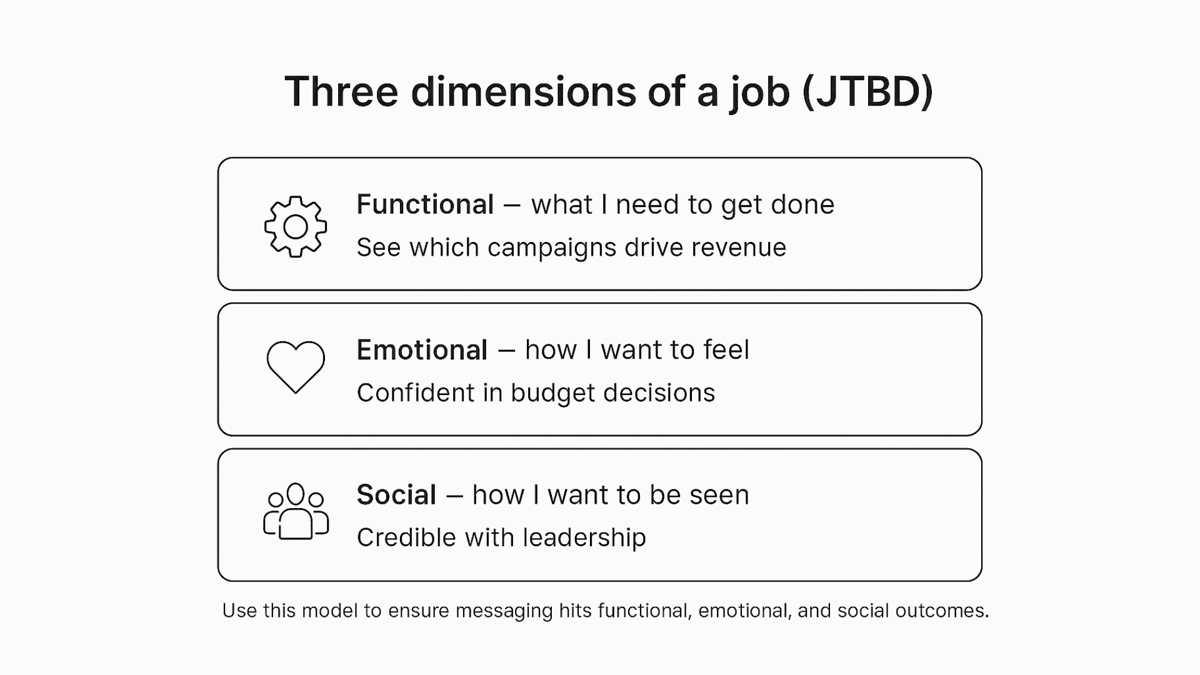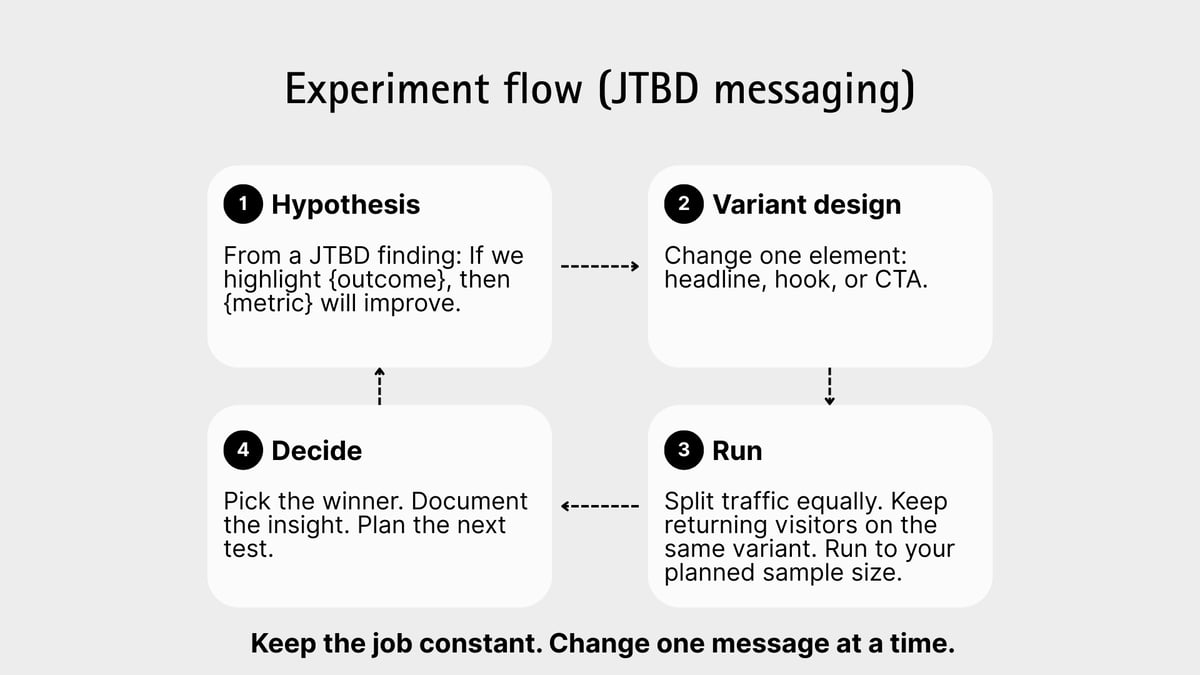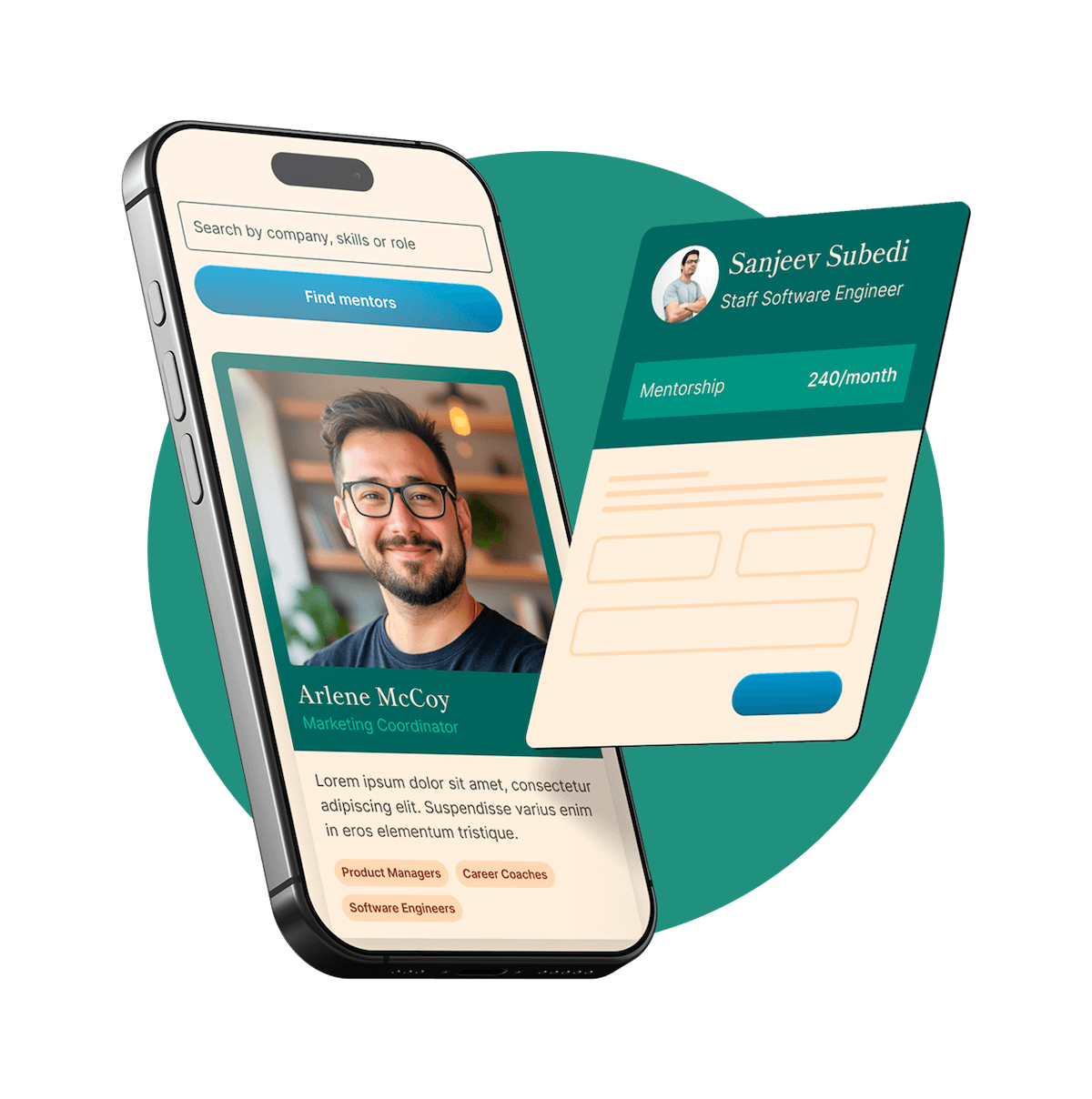Your product messaging fails to connect with customers even though you have developed it with great care. You're not alone. Most PMMs experience this situation when messages seem correct to them, but customers don’t respond.
Here's what's happening. Every job people need or want to do has three dimensions: social, functional, and emotional. But most marketing approaches miss these deeper motivations entirely. We get caught up in feature lists and benefit statements while customers are thinking about the progress they're trying to make in their lives.
Jobs to be done (JTBD) research cuts through this noise. Instead of shouting features at potential customers, JTBD recognizes that people "hire" products to accomplish specific tasks or "jobs". This shift changes everything about how you approach messaging.
The main question that needs to be answered is: what jobs arise in your customers' lives for which they might hire your product?. And a response to this question will give you a foundation for messaging that actually resonates with your audience. Not just with what you think customers want, but with what they're trying to accomplish.
In this article, you’ll learn how to perform JTBD interviews, how to understand authentic customer needs, and how to use this information to create effective messaging for your target audience. I’ll share best practices for conducting interviews and converting collected data into the copy that resonates with customers’ needs.
The JTBD framework enables you to understand your customers in a new way. You should focus on their objectives instead of figuring out who they are. The new way of thinking allows us to develop more efficient and clear communication.
Clayton Christensen introduced JTBD through his idea that customers choose solutions instead of individual product features. As the classic line goes, no one wants a quarter-inch drill they want a quarter-inch hole. Start with the “Job” itself before you proceed to identify its functional aspects and emotional and social components.
The framework breaks down like this: focus on the job your customer is trying to accomplish, not the features your product offers. Every job has three dimensions that matter:

Here's why this matters for product marketers. Jobs stay consistent over time while products change constantly. The fundamental job of "getting dinner on the table quickly after work" hasn't changed in decades, but the solutions have evolved from TV dinners to meal kits to food delivery apps. Understanding the job gives you marketing insights that last.
Most personas describe who someone is. JTBD explains why they buy in a given moment. The same person behaves differently by circumstance: ‘hosting a dinner’ and ‘grabbing lunch between meetings’ are different jobs. Circumstance covers the trigger, timing, stakes, and constraints that push action. Segment on circumstance to shape the promise, then use personas to tune channel, tone, and proof for each role. Rule of thumb: job = the outcome you promise; persona = the proof and path you use to deliver it.
Good JTBD messaging sounds different. Instead of listing features, you're solving problems. Instead of generic benefits, you're addressing specific progress customers want to make.
Consider these two approaches:
Persona-based: "Frequent travelers need a reliable suitcase"
JTBD-based: "Get through the airport smoothly with your suitcase that glides easily, fits in the overhead bin, and keeps everything organized"
The second version frames the job more clearly. It’s not just about owning a “reliable suitcase,” it’s about making travel less stressful and more efficient. That framing brings together the functional (ease of use), emotional (reduced stress), and social (looking prepared and professional) dimensions that drive the purchase.
The JTBD framework helps you:
When you align messaging with the progress customers are trying to make, your communication feels natural rather than forced. You're not selling, but you're solving.
Good JTBD research is essential for successful product marketing work. But most teams approach these conversations all wrong. They approach JTBD interviews like traditional market research, asking customers to rationalize their decisions after the fact.
And that approach is incorrect from the beginning.
JTBD interviews work best when it feels like you're filming a documentary, not conducting an interrogation. Bob Moesta, who co-created the JTBD framework, puts it this way:
"Set a casual, conversational tone from the beginning. Ask for first names of people, places, dates. Almost like you want to shoot a documentary."
Your setup statement makes all the difference, a proper introduction sets the stage. You could say: “I’m conducting early research to understand the thought process when considering our product to improve overall experience. I’m not looking for correct answers, just your own experience.”
Focus your research on three groups:
These people can still recall the circumstances and emotions around their decision-making process.
JTBD conversations follow the customer's story chronologically, starting with their world before they even knew they had a problem.
Here's a framework that I use in my work:
Situation context: “Walk me through what was happening when you realized you might need a new solution.”
Struggle identification: “What made your current approach so frustrating that you started looking for alternatives?”
Solution exploration: “How did you begin searching for other options? What did you look for online?”
Decision triggers: “What ultimately convinced you this was the right choice?”
Experience validation: “When did you first feel, ‘Yes, this is working for me’?”
The common pitfall is asking why. “Why” prompts people to justify their choices. Instead, focus on specifics: “What time of day was it?” or “Who else was involved?”, so responders can replay the moment and recall the emotions that influenced their decision.
Every customer decision involves functional, emotional, and social factors. Miss any one of these, and you'll craft incomplete messaging.
Functional jobs are the easiest to spot. Ask: "When you're using that product, what are you ultimately trying to get done?" These reveal the practical outcomes customers need.
Emotional jobs require more finesse. Try questions like "What did that experience mean to you?" or "How did solving this problem make you feel?" Don't rush past these answers–they often contain the most powerful messaging insights.
Social jobs are the trickiest because people don't always admit they care what others think. Watch for clues: "How did your team react when you suggested this solution?" or "Was it important that others could see you were using this? Why?" People make choices based on how they want to be perceived by colleagues, family, or peers.
Pay attention to contradictions between what customers say they value and what they actually do. As one researcher noted, "Sometimes the most valuable insights come when a person's actions don't fully align with their stated preferences." These gaps often reveal unspoken social or emotional jobs.
The goal isn't to conduct perfect interviews, it's to understand the complete picture of what drives customer decisions. When you can see all three job dimensions clearly, you have the foundation for messaging that actually connects with how people think and feel about their choices.
Your JTBD interviews are complete. You've got pages of notes about customer motivations and real stories about why people buy. Now comes the hard part: turning those insights into messaging that actually moves the needle.
Here's where most product marketers stumble. They take a perfectly good customer insight and turn it into corporate speak. Instead of "efficient meal preparation amid professional and parental responsibilities," try "dinner made easy–even on your busiest nights." See the difference? The second version sounds like something a real person would say.
Start with how your customer would naturally describe their need. Then craft your message around that language.
A simple structure helps with this translation:
The most effective messaging hits functional, emotional, and social needs simultaneously. Research shows that when companies connect with customers' emotions effectively, the results can be remarkable, one credit card designed for emotional connection increased usage by 70% among its target segment.
Don't stop at functional benefits. Tap into identity and aspirations. Rather than positioning a financial app as "an all-in-one solution," frame it as "your money, your rules" to emphasize the empowerment customers seek. This identity-focused approach creates messaging that sticks because it reflects how people actually think about their needs.
Product marketers fall into this trap constantly, they list what their product does instead of communicating what customers get. According to Strategyn, JTBD helps "communicate offerings effectively" by aligning "the entire organization around a clear and consistent messaging strategy that speaks to the problem".
Test your messaging against the job statement by asking: "Does this speak directly to that job?" If your copy feels product-focused rather than customer-focused, go back to the original customer insight.
Your JTBD insights won't mean much if your messaging doesn't actually work in the real world. Even the most thoughtfully crafted messages need validation through rigorous testing.
A/B testing gives you a direct way to measure whether your JTBD-based messaging actually resonates. At Pipedrive, I worked on upselling a lead generation add-on. We struggled with adoption because many customers either weren’t aware of the add-on or didn’t see it as relevant to their needs. I ran a series of JTBD interviews to identify the obstacles and found we were trying to address two very different jobs with a single pitch. After updating the messaging on our key pages and in customer communications, we saw a clear uplift in conversions, both to trial and to purchase.

Here's how to set up effective tests:
Failed tests still teach you something valuable about what your audience cares about or doesn't.
Your JTBD insights need to match where prospects are in their decision process. The messaging should shift as customers move through their journey, addressing different aspects of the same job at each stage.
Pick two or three value propositions that matter most to your audience from your JTBD statements. These become your messaging foundation across every touchpoint, like awareness campaigns, consideration content, and decision-stage materials.
Try "fake door" tests using targeted ads before you build new features. This quickly validates which value propositions hit hardest with your audience.
Several traps can sink your JTBD messaging efforts:
Customer needs evolve. What worked six months ago might fall flat today. Keep testing and retesting your JTBD messaging to stay relevant.
JTBD messaging is about getting results not just feeling better. The question becomes: how do you measure whether your job-focused approach is actually moving the needle?
Brand association with key jobs serves as your most telling performance indicator. As you build stronger connections in customers' minds between their jobs and your brand, you need to track how your brand stacks up against competitors for these key jobs. This measurement shows your marketing effectiveness over time.
Here's how to track this connection:
Customers measure progress along three dimensions, it means faster completion (time), more predictable results (reliability), and greater efficiency (without waste). Your tracking should reflect these dimensions.
JTBD creates stronger product-market fit, which directly impacts customer lifetime value. Once you acquire a customer through job-focused messaging, you establish a mental pathway between their job and your product. This makes them less susceptible to competing messages.
This connection compounds over time as customers develop habits around your solution. Look at jobs you don't currently solve, these become opportunities for growth through new features or products that serve additional customer needs.
Jobs stay relatively stable, but circumstances change. Consider revisiting your research when:
During revisits, examine whether your metrics show progress on outcomes customers value like time savings, reliability improvements, or efficiency gains.
The degree to which each outcome is satisfied creates a baseline that makes innovation more reliable than gut-feeling approaches. When you can measure customer progress accurately, you can predict product success more confidently.
Jobs to be done changes how product marketers think about their audience. Instead of guessing what customers want based on demographics or assumptions, JTBD reveals what they're actually trying to accomplish. This shift makes all the difference.
The framework works because it focuses on progress, not products. Customers hire your solution to get a job done, meaning functional, emotional, and social. When you understand those three dimensions, your messaging stops sounding like everyone else's and starts connecting with real motivations.
The research process itself provides unexpected value. Those JTBD interviews uncover language your customers actually use, not the polished terms you find in competitor marketing. This authentic voice becomes the foundation for messaging that feels natural rather than forced.
But here's where most product marketers get stuck: translation. You can have perfect research insights, but if you can't turn them into compelling value propositions, the work stops there. The key is focusing on outcomes customers seek rather than features you've built.
Testing validates everything. A/B test your JTBD messaging against your current approach. Map different job dimensions to various stages of the buyer journey. Track how strongly customers associate your brand with the jobs they need done. These metrics tell you whether your messaging actually works.
The measurement piece matters more than most teams realize. Brand association with key jobs becomes your competitive moat. When customers think of their job, they should think of your solution. That mental connection drives customer lifetime value and makes you less vulnerable to competitive messaging.
Start simple. Pick one core job your product solves. Interview recent customers about their decision process. Identify the functional, emotional, and social dimensions. Craft one piece of messaging around that job. Test it. Measure the results.
Your product messaging doesn't have to fall flat. JTBD gives you a framework for creating messages that actually matter to customers, because they speak directly to the progress people are trying to make.
Find out if MentorCruise is a good fit for you – fast, free, and no pressure.
Tell us about your goals
See how mentorship compares to other options
Preview your first month
